![]()
This page is also available in French
![]()
The Caffè was opened by a Greek (hence its name) in 1760, and throughout the 18th and 19th centuries was a favourite meeting place for foreign artists. Writers and poets such as Keats, Byron and Goethe, and composers like Berlioz, Mendelssohn, Liszt, Wagner and Bizet were among its visitors. Laminated facsimiles of letters, old newspaper cuttings and photographs of some of the famous visitors now adorn the walls of the café.
Caffè Greco, located at No. 86 on the Via Condotti off the Piazza di Spagna, is very close to the Villa Medici and was the usual haunt of the Prix de Rome pensioners at the time of Berlioz’s visit. His reaction to the Caffè Greco should be read in the context of his jaded view of Rome, expressed for example in a letter to his family a few weeks after his return from Nice (CG no. 232, 24 June 1831):
[…] Sometimes I try to go down to Rome, but I get even more bored there; there is no spectacle, not a shade of music, no library, only dirty, dark cafés where service is poor and there are no newspapers; in the country of marble you are served on miserable little wooden tables like the table in the kitchen which supports the lamp. Everything here is 150 years behind civilisation, and the same is true of the whole of Italy. […]
Rome, in other words, was not Paris where cafés like the Café Le Cardinal were one of Berlioz’s favourite haunts. But there was no way of avoiding the Caffè Greco. On the very day of his arrival Berlioz went there, as he relates in his Memoirs (chapter 33):
That same evening, after paying my respects to M. Vernet, I followed my comrades to their usual meeting place, the famous café Greco. It really is the most detestable tavern you can find: dirty, dark and humid, nothing can justify the preference given to it by the artists of all nations who reside in Rome. But its proximity to the Piazza di Spagna and to the Lepri restaurant opposite attracts a considerable number of customers. One kills time there by smoking execrable cigars and drinking a coffee that is no better, which is served not on marble-top tables as everywhere else, but on little wooden tables the size of the top of a hat, black and sticky as the walls of this delightful place. All the same the Cafe Greco is so frequented by foreign artists that the majority use it as a postal address, and the newly arrived have no better way of meeting compatriots than by going there.
Visits to the Caffè Greco were indeed part of the social routine in Rome, as Berlioz relates later in the Memoirs (chapter 36):
In the evening, it was the obligatory visit to the café Greco, where the French artists who are not attached to the Académie, whom we call the men from down below, smoke the cigar of friendship with us, while drinking the punch of patriotism. After which, all would disperse…
Berlioz goes on to say that ‘the virtuous’ would return to the Villa Medici where they might entertain themselves with improvised music; he leaves it to the reader’s imagination to determine where the others went.
![]()
All the photographs reproduced on this page were taken by Michel Austin in May 2007, and other pictures have been scanned from publications in our collection. © Monir Tayeb and Michel Austin. All rights of reproduction reserved.
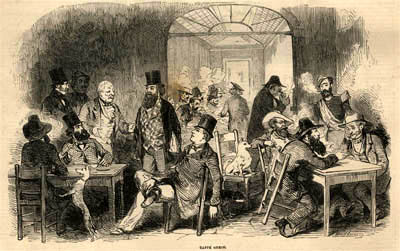
The above engraving was published in the Illustrated London News, 4 May 1850.
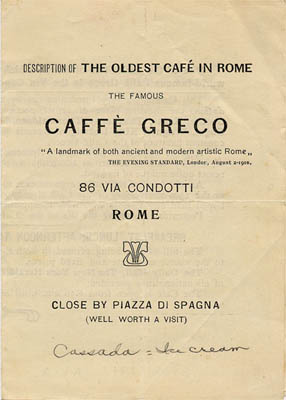
According to this small 4-page contemporary information pamphlet, ‘This café has a very interesting history, having been since 1760 (the date of its foundation) the meeting place of artists, poets, and writers of all countries. Byron, Shelley, Goethe, Keats, Thackeray, Thorwaldsen, Mark Twain, Canova, Gounod, Bizet, Berlioz, Gogol, Wagner, King Ludwig of Bavaria and many other world celebrities having been constant habitués of the Caffè Greco.’
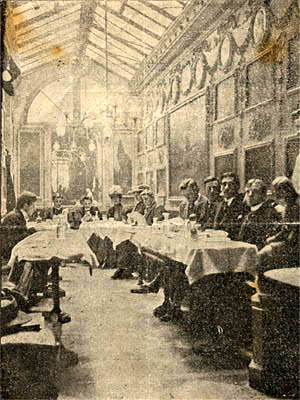
This photo, printed in the above pamphlet, shows the Medallion room, ‘commonly known as THE OMNIBUS on account of its shape.’
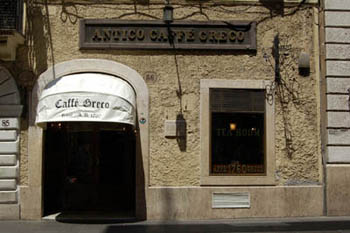
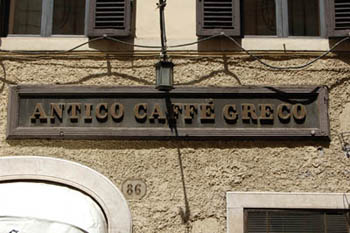


![]()
© Michel Austin and Monir Tayeb for all the pictures and information on this page.
Copyright notice: The texts, photos, images and musical scores on all pages of this site are covered by UK Law and International Law. All rights of publication or reproduction of this material in any form, including Web page use, are reserved. Their use without our explicit permission is illegal.